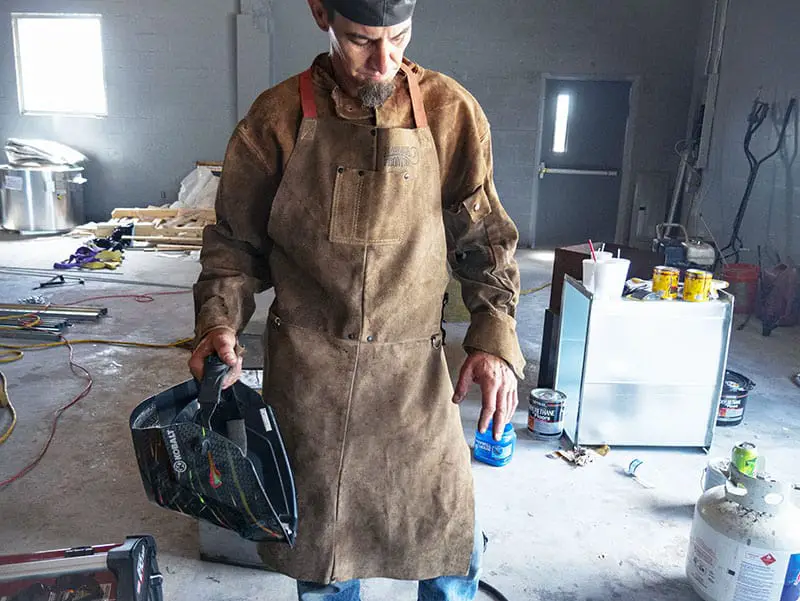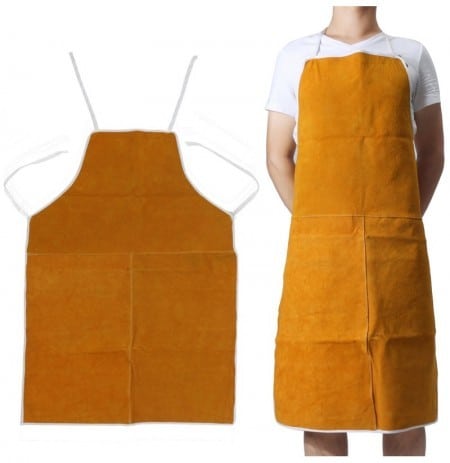Welding is the technique of bonding materials, typically metals or thermoplastics, by melting components together at high temperatures.
And as we can comprehend, this is a dangerous procedure, and precautions must be taken to avoid burns, electric shock, visual loss, excessive UV radiation exposure, and inhalation of poisonous gases and fumes.
Therefore, to protect the welder from any harm, personal protective equipment (PPE) is required. Gloves to protect the hands, goggles for the eyes, helmet to protect the head, and aprons for the torso and upper legs.
When wearing a welding apron, you are protecting yourself and your clothing from hot metal and slag created when welding, grinding, or using a cutting torch, and it is for this reason welders wear aprons for their overall safety.
Welding aprons will keep you safe from:
-
-
- The electric spark
- Heat
- Flames
- Cuts
- Burns
-
To be more specific, any 100% leather apron would be ideal for welding protection. The best protection, however, is provided by cotton aprons sprayed with flame retardant coatings.
Why is an apron important while welding?
When welding, you must work with heat, electricity, flame, gas, cutting tools, heavy machinery, and so on. As a result, while welding, you must wear a protective apron.
Because of the following reasons, you should always wear a welding apron:
1.) Aprons for welding makes sure that your clothing will not catch fire if sparks fly.
2.) Welding aprons keeps the heat and flames away from your body.
3.) Welding aprons keep you safe from being cut by any sharp cutting instruments.
4.) Welding aprons prevent electric current from passing through your body.
5.) Wearing an apron when welding shields you from the hot metal flakes, slag, and flames created during the welding process.
Categories of apron depending on protection level
Several types of welding aprons are recommended for various conditions. We will go through the most common types of welding aprons to help you decide which one is best for you.
1.) Aprons for Basic Protection
These aprons are lightweight, comfortable, provide enough protection, and are convenient. They are utilised in a variety of industries such as healthcare, maintenance, manufacturing, and construction. Some of these aprons are used in laboratories, while others are disposable.
2.) Aprons with Flame-Resistant Fabric
These aprons are best suited for work conditions that expose people to flame, extreme heat, or an electric arc. These are flame-retardant aprons that protect workers when they are exposed to extreme heat or an open flame.
Different styles of welding apron
1.) Full coverage- A long welding apron is typically 40′′, approximately 101 cm- 36′′ (91.5 cm) in length. This extends from the upper chest to the legs for the normal adult.
2.) Half coverage- A waist apron covers the upper legs and begins at the waist. It’s especially useful for projects that require you to work on a table or a platform.
Most waist welding aprons exist in a variety of sizes, but they are normally no longer than an adult’s knees.
3.) Split leg apron- A long welding apron can be inconvenient when you need to walk and kneel a lot because the part under the knees can get in the way.
As a result, split leg welding aprons are more practical. This is essentially an apron with straps around each leg to allow for greater mobility.
Different welding apron fabrics
1.) Cowhide leather aprons- The ideal material for welding aprons is leather, preferably cow skin leather. It’s tough and resistant to heat and flame. All of this comes at a cost as it might be more expensive and heavier to wear all day.
Leather is a natural substance that should not be washed or come into touch with water. Even yet, the majority of folks prefer leather for their welding aprons.
| Pros | Cons |
| Heat and flame resistance.
Strong and long-lasting. |
It is costly.
Water cannot be used to clean it. |
2.) Cotton aprons- These are flame retardant cotton aprons that protect against extreme heat and open flames. The most affordable welding aprons are often composed of fire-resistant cotton.
They still provide adequate protection against heat and fire, although they are not as long-lasting as leather.
| Pros | Cons |
| Less expensive than other materials.
Resistant to fire. It is washable. |
Not very durable.
Not ideal for metal works. |
Importance of leather apron in welding-
1.) Leather is essentially toughened animal skin that protects the wearer from the elements.
2.) Leather aprons are constructed in such a way that they provide complete protection from welding risks such as flying molten metals, blazing particles, high heat, sparks, and electric arcs.
3.) The full leather aprons protect the wearer’s chest, abdomen, and thighs, as well as all internal systems that may be affected by the intense heat generated during the welding process.
4.) Leather aprons are also resistant to cuts and do not easily catch fire.
How to choose the ideal welding apron?
1.) It is critical to select a comfortable style. Check that it fits you properly because an unpleasant piece of clothing is less likely to be worn. Even after extended periods of time, a comfortable fit helps provide a smoother welding process.
2.) Welding aprons that wrap, clip, or tie at the waist may be more comfortable and provide protection from the waist down. Of course, you’ll need some kind of welding jacket to cover your upper body.
3.) Others might choose a complete welding apron that resembles a chef’s apron. These one-piece aprons obviously give additional covering and protection.
4.) Because welders come in a variety of sizes, aprons of varying lengths are available.
As a result, regardless of your build, selecting the proper cut and style is rather simple.
→ When selecting the ideal apron for yourself, you should examine your welding technique as well as the welding duties at hand.
Long aprons, for example, offer greater protection and safety. However, mobility and practicability must also be considered.
→ Half-cut aprons give less protection than longer aprons but more movement and comfort.
Split leg welding bibs are the best method to achieve both movement and covering.
→ In other words, your apron should just fit nicely to your body, despite the fact that it has protected your complete front from welding sparks and heat.
However, here we provide you with tips on how to properly wear your apron so that it fits perfectly:
1.) Cover your front body with the apron, making sure that no vulnerable areas are exposed.
2.) Tie the waist drawstrings behind you just enough to make you feel comfortable while still allowing you to breathe and move freely. It should not be too tight around the waist.
3.) If your apron has a knot in the neck area, make sure it’s not too loose or too tight so your neck doesn’t hurt.
What should you wear while welding?
You should consider wearing the following types of clothes when welding:
1.) Light tones will keep you cooler.
2.) Long-sleeved shirts that cover your full arm.
3.) Shirts with collars to protect your neck.
4.) The shirt cuffs should be buttoned so that no sparks or flames enter through them.
5.) Shirts with flap pockets to prevent the pockets from collecting the leftovers of flying hot molten metals.
6.) The bottom of the jeans should cover the boots, exposing no part of the upper foot to the flames or heat.
See also: What Shirts Do Welders Wear?
Conclusion
Since we have already covered the importance of wearing an apron while welding. Just keep in mind that your safety should be your first priority.
Wear your apron to protect yourself from welding hazards!
Wearing an apron when welding shields you from the hot metal flakes, slag, and flames created during the welding process.
These are flame-retardant aprons that protect workers when they are exposed to extreme heat or an open flame.








